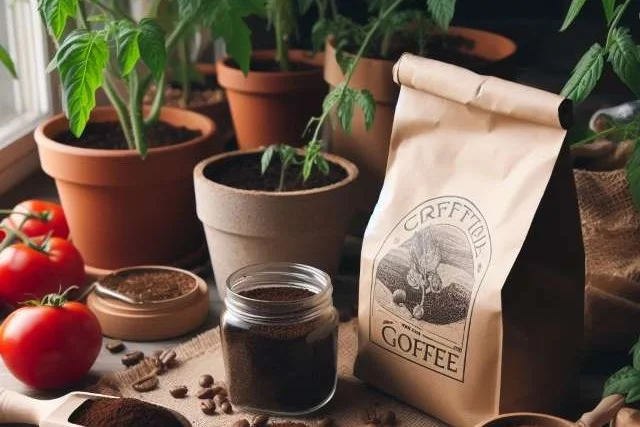Are Coffee Grounds Good for Tomato Plants? A Complete Guide
Are coffee grounds good for tomato plants? The short answer is yes, coffee grounds can provide some great benefits for tomato plants when used correctly. Keep reading to explore the pros and cons of using coffee grounds for tomatoes and get some handy tips on how to use them effectively.
Are coffee grounds good for tomato plants? Key Takeaways
- Coffee Ground Benefits: Used coffee grounds offer essential nutrients like nitrogen, phosphorus, and potassium, promoting robust growth in tomato plants.
- Improves Soil Health: Properly applied coffee grounds enhance soil drainage, aeration, and acidity, creating an optimal environment for tomatoes to thrive.
- Potential Pitfalls: Excessive use can upset pH balance and salinity, emphasizing the need for moderation and correct application to avoid adverse effects.
- Best Practices: Guidelines include using fresh grounds, avoiding flavored or instant coffee, and incorporating the grounds into the soil or using them as mulch in small, regular amounts.
Coffee Grounds: A Natural Boost for Your Tomato Plants

Coffee grounds are the leftover debris from brewing coffee. Rather than throwing used coffee grounds in the trash, many gardeners have started using them in their vegetable and flower gardens as a soil amendment and fertilizer.
Coffee grounds contain essential nutrients that are beneficial for plants, including nitrogen, phosphorus, potassium, and copper. When used appropriately, coffee grounds can improve soil drainage and aeration, add organic matter, and provide a slow-release fertilizer for plants.
Tomato plants can certainly reap advantages from coffee grounds. The nutrients in coffee grounds give tomatoes an extra boost, especially nitrogen which is crucial for leaf and stem growth. The organic matter also helps loosen and enrich the soil to support stronger root systems and plant health overall.
However, there are some caveats. Too many coffee grounds can adversely impact plants by upsetting pH balance and salinity. Proper application is key. When used correctly in moderation, coffee grounds can be an excellent addition to tomato beds.
Benefits of Using Coffee Grounds on Tomato Plants
Using coffee grounds as mulch or mixed into soil provides several benefits for tomato plants:
Improves Soil Drainage
Coffee grounds are porous and loose, allowing water, air, and nutrients to better permeate the soil. This improves drainage and prevents puddling. Good drainage is essential for preventing root rot and other issues in tomatoes.
Adds Essential Nutrients
Coffee grounds contain nitrogen, phosphorus, potassium, magnesium, and copper. Tomatoes need high levels of nitrogen and potassium. The slow release of nutrients from decomposing grounds provides steady fertilization.
Suppresses Plant Diseases
Studies show coffee grounds can help suppress or prevent certain tomato fungi and diseases like fusarium, verticillium, and early blight. The grounds contain compounds that inhibit growth and spread.
Increases Soil Acidity
Tomatoes prefer slightly acidic soil in the 6.0 to 6.5 pH range. Coffee grounds contain organic acids that lower pH levels. This helps tomatoes access nutrients like iron, zinc, and manganese.
Promotes Root Growth
The nutrients, drainage, and aeration benefits of grounds foster stronger, healthier root systems in tomatoes. Better roots mean better growth and fruit production.
Attracts Earthworms
Worm castings further enrich the soil. Coffee grounds attract earthworms which till and fertilize the soil.
Table 1: Using Coffee Grounds on Tomatoes – Benefits and Best Practices
| Benefit | Description |
| Improves soil drainage | Porous texture creates aeration. |
| Provides nutrients | Nitrogen, phosphorus, potassium, copper. |
| Suppresses diseases | Inhibits fusarium, verticillium, etc. |
| Acidifies soil | Lowers pH closer to ideal for tomatoes. |
| Boosts roots | Nutrients and soil properties promote growth. |
| Deters pests | Caffeine can act as an insecticide. |
| Best Practice | Details |
| Use fresh grounds | Highest in nitrogen and nutrients. |
| Avoid flavored/instant | Can alter soil chemistry. |
| Mix into soil | Prevents burning and molding. |
| Start with small amounts | 1 part grounds to 4 parts soil. |
| Water after application | Washes nutrients in and prevents burning. |
| Alternate with compost | Balances pH and nitrogen. |
How Much Coffee Grounds to Use on Tomato Plants

When using coffee grounds on tomatoes, moderation is key. Here are some general guidelines on quantity:
- As a soil amendment when planting, mix 1 part grounds with 4 parts soil. For example, 1 cup grounds per 4 cups of soil.
- For side dressing during the season, use 1-2 tablespoons per square foot around plants every 2-3 weeks.
- For mulch, apply a thin 1/4 inch layer and scratch into the top 1-2 inches of soil.
Too many grounds can overwhelm plants. Start with smaller quantities and gradually increase if plants show no adverse effects. Always thoroughly mix grounds into soil or water after application to prevent burning.
How to Apply Coffee Grounds to Tomato Plants
There are a few techniques for incorporating used coffee grounds into tomato beds:
- Work grounds into the soil 2-3 weeks before planting tomatoes. Mix in thoroughly to prevent clumping.
- Side-dress existing plants by lightly sprinkling grounds around the base every few weeks. Follow with watering.
- Use grounds as mulch by sprinkling a thin layer around plants. Scratch into soil and water.
- Make coffee ground tea to use for watering. Steep grounds in water for a few days then strain. Dilute tea before use.
- Add grounds to compost that will be mixed into beds before planting. Finished compost reduces the risk of over-acidity.
No matter the method, always apply evenly and water after to prevent burning concentrated patches.
Best Coffee Grounds for Tomato Plants
Not all coffee grounds are created equal. Here are some tips on choosing the best grounds for tomatoes:
- Use fresh grounds – Fresh grounds are highest in nitrogen and other nutrients versus spent grounds. The fresher the better.
- Avoid flavored coffee – Flavored grounds like vanilla or hazelnut can alter soil pH. Stick to plain coffee.
- Don’t use instant – Instant coffee contains extra chemicals. Regular filtered coffee is best.
- Avoid oils – Oily grounds like espresso can go rancid, breeding molds in soil. Opt for filtered coffee.
- No decaf – Decaf is processed chemically. The compounds may be harmful to tomato plants.
- Rinse used grounds – Rinsing will remove any lingering coffee oils. Helps avoid soil toxicity.
How Often to Apply Coffee Grounds to Tomato Plants

When first using coffee grounds, start slowly and increase frequency gradually:
- Apply grounds every 2-3 weeks maximum at first.
- Observe plants for 2 weeks after each application. Look for signs of burning like wilting leaves or yellowing.
- If no issues, can increase to applying grounds weekly.
- During hot weather, reduce application to once a month. Heat accelerates decomposition and nutrient release.
Again, moderation is key. Monitor regularly and cut back at any sign of overload.
Tips for Using Coffee Grounds on Tomatoes
Follow these tips to safely and effectively use spent coffee grounds on tomato plants:
- Pick a sunny, dry day to apply grounds to reduce the risk of mold growth.
- Alternate coffee ground feedings with high-nitrogen fertilizers. Don’t overdo nitrogen.
- Water thoroughly after applying to wash nutrients into the soil and prevent burning.
- Use less grounds in hot weather to avoid accelerated nutrient release.
- Sprinkle lightly around plants. Don’t mound grounds next to stems.
- Till into soil to prevent grounds from molding or forming crust.
- Combine with compost or organic matter to balance pH and nitrogen levels.
Common Mistakes to Avoid

It’s easy to overdo it with coffee grounds. Here are some key mistakes to avoid:
- Don’t assume more is better. Too much can burn, overwhelm, or alter soil chemistry. Start small.
- Avoid dumping or spot-treating with grounds. Spread evenly and mix in thoroughly.
- Don’t apply grounds without watering after. Grounds will crust and burn without moisture.
- Don’t use instant coffee or oily grounds like espresso. The chemicals can harm plants.
- Don’t put grounds directly in a planting hole. Mix with surrounding soil instead.
- Don’t use fresh grounds in hot weather. Nutrients break down too quickly.
- Don’t use grounds as lone fertilizer. Combine with compost and balanced organic feeds.
Table 2: Troubleshooting Coffee Grounds on Tomatoes
| Issue | Cause | Solution |
| Burned leaves | Grounds applied too heavily | Water immediately after applying. Mix into soil instead of mounding. |
| Wilting, yellowing | Nutrient overload | Cut back on amount and frequency of grounds. |
| Poor fruit set | Excess nitrogen | Balance grounds with phosphorus-rich compost or fertilizer. |
| Lower pH | Too much acidity from grounds | Add lime or wood ash to balance pH. |
| Moldy soil | Damp grounds not tilled in | Pick dry day to apply. Mix into dry soil and don’t overwater. |
| Stunted plants | High salinity | Leach soil with heavy watering to remove salt buildup. |
More Than Tomatoes – What Other Plants Love Coffee Grounds?
Tomatoes aren’t the only plants that can benefit from used coffee grounds. What other species appreciate the nutritional boost from your morning brew?
Roses thrive with coffee grounds worked into their beds. The nitrogen provides gorgeous green growth and magnificent blooms. The grounds also help loosen heavy soil for better rose root development. Christmas cacti are another coffee fan. The acidity helps these tropical plants absorb nutrients. Sprinkling grounds when watering prevents mineral buildup.
The nutrients and organic matter in coffee grounds make them a versatile garden amendment. With proper application, flowers, trees, and vegetables alike can gain an energizing lift from spent grounds. Experiment to find out which plants perk up most with this free fertilizer full of potential.
Final Thoughts: Are Coffee Grounds Good for Tomato Plants?
When used properly, coffee grounds can be a safe, effective fertilizer and soil amendment for tomato plants. The nutrients, organic matter, and pH benefits support stronger tomato growth and production.
Be sure to apply coffee grounds in moderation by mixing thoroughly into the soil, alternating feedings with other fertilizers, reducing amounts in hot weather, and watering immediately after. This prevents burning and overload issues.
With a little care and observation, used coffee grounds can be a bountiful garden bonus for your backyard tomatoes. Put those leftovers from your morning brew to good use!
Frequently Asked Questions About Using Coffee Grounds on Tomatoes
Coffee grounds can hurt tomato plants if used incorrectly. Applying too many coffee grounds at once can burn plants or cause over-fertilization. It’s important to use coffee grounds in moderation and water thoroughly after application. Start with small amounts and increase gradually while monitoring plants.
There is some evidence that coffee grounds can help repel or deter tomato hornworms and other pests. Coffee contains caffeine and other compounds that can have an insecticidal effect. Sprinkling used grounds around tomatoes may help create a barrier to protect plants.
There is no definitive evidence that using coffee grounds improves tomato flavor. However, by providing essential nutrients to plants, coffee grounds can promote healthier, more robust tomato growth which leads to better-tasting fruit overall. The benefits to soil health also cultivate stronger-flavored tomatoes.
It’s best not to put fresh coffee grounds directly on tomato plant leaves and stems. The grounds can damage or burn the plants. Always mix grounds into the surrounding soil and water thoroughly after application. As they break down, the nutrients will reach plant roots safely.
Coffee grounds break down fairly quickly, releasing most of their nutrients within 4-6 weeks. To provide a steady fertilizer source, re-apply coffee grounds every 2-3 weeks over the growing season. Adding compost reduces the breakdown rate for a longer feeding duration.








